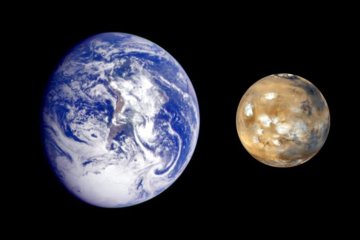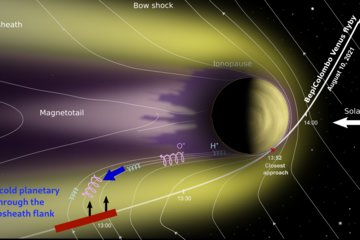All genres
81.
Journal Article
Hubble Space Telescope Observations of Active Asteroid 324P/La Sagra. Astronomical Journal 152, 77 (2016)
82.
Journal Article
Fragmentation Kinematics in Comet 332P/Ikeya-Murakami. Astrophysical Journal 829, L8 (2016)
83.
Journal Article
Gas outflow and dust transport of comet 67P/Churyumov-Gerasimenko. Mon. Not. Roy. Astron. Soc. 462, pp. S533 - S546 (2016)
84.
Journal Article
Geomorphological mapping of comet 67P/Churyumov-Gerasimenko's Southern hemisphere. Mon. Not. Roy. Astron. Soc. 462, pp. S573 - S592 (2016)
85.
Journal Article
Observations and analysis of a curved jet in the coma of comet 67P/Churyumov-Gerasimenko. Astronomy and Astrophysics 588, L3 (2016)
86.
Journal Article
The dust environment of comet 67P/Churyumov-Gerasimenko from Rosetta OSIRIS and VLT observations in the 4.5 to 2.9 AU heliocentric distance range inbound. Astronomy and Astrophysics 587, A155 (2016)
87.
Journal Article
The southern hemisphere of 67P/Churyumov-Gerasimenko: Analysis of the preperihelion size-frequency distribution of boulders >= 7m. Astronomy and Astrophysics 592, L2 (2016)
88.
Journal Article
The Agilkia boulders/pebbles size-frequency distributions: OSIRIS and ROLIS joint observations of 67P surface. Mon. Not. Roy. Astron. Soc. 462, pp. S242 - S252 (2016)
89.
Journal Article
Aswan site on comet 67P/Churyumov-Gerasimenko: Morphology, boulder evolution, and spectrophotometry. Astronomy and Astrophysics 592, A69 (2016)
90.
Journal Article
Summer fireworks on comet 67P. Mon. Not. Roy. Astron. Soc. 462, pp. S184 - S194 (2016)
91.
Journal Article
Geomorphology of the Imhotep region on comet 67P/Churyumov-Gerasimenko from OSIRIS observations. Astronomy and Astrophysics 583, A35 (2015)
92.
Journal Article
Search for satellites near comet 67P/Churyumov-Gerasimenko using Rosetta/OSIRIS images. Astronomy and Astrophysics 583, A19 (2015)
93.
Journal Article
Orbital elements of the material surrounding comet 67P/Churyumov-Gerasimenko. Astronomy and Astrophysics 583, A16 (2015)
94.
Journal Article
Fast Rotation and Trailing Fragments of the Active Asteroid P/2012 F5 (Gibbs). Astrophysical Journal 802, L8 (2015)
95.
Journal Article
Regional surface morphology of comet 67P/Churyumov-Gerasimenko from Rosetta/OSIRIS images. Astronomy and Astrophysics 583, A26 (2015)
96.
Journal Article
Spectrophotometric properties of the nucleus of comet 67P/Churyumov-Gerasimenko from the OSIRIS instrument onboard the ROSETTA spacecraft. Astronomy and Astrophysics 583, A30 (2015)
97.
Journal Article
Rotating dust particles in the coma of comet 67P/Churyumov-Gerasimenko. Astronomy and Astrophysics 583, A14 (2015)
98.
Journal Article
Gravitational slopes, geomorphology, and material strengths of the nucleus of comet 67P/Churyumov-Gerasimenko from OSIRIS observations. Astronomy and Astrophysics 583, A32 (2015)
99.
Journal Article
A New Active Asteroid 313P/Gibbs. Astronomical Journal 149, 81 (2015)
100.
Journal Article
Episodic Ejection from Active Asteroid 311P/PANSTARRS. Astrophysical Journal 798, 109 (2015)











